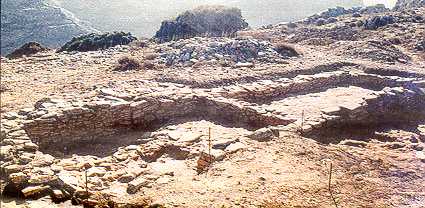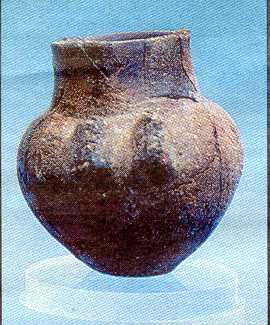
Issue A014 of 9 December 2001
A Fortified Town of the Aegean Late Neolithic or Chalcolithic

By Appolo Basantes
Independent Scholar
Greek archaeologists have recently discovered a Late Neolithic or Chalkolithic period settlement that dates back to 5,000 BC on the island of Andros, the Cyclades, Greece. This settlement (which is actually a town, by the standards of that era) lies on the Strofilas plateau in western Andros and is unique in many ways.
It is large, intensively built, fortified and very well preserved. The main body of the town stretches in an area of about three hectares and has --among others-- a number of big, rectangular, arch-ending buildings. Other findings include refined artwork (pottery, jewels), utilities, stone tools and weapons equipped with opsidian stone pikes, as well as figurines and many objects made of copper. Due to the variety and quantity of the latter, prehistoric  archaeologists might have to reconstruct some of their views, regarding the start and level of metallurgy in the Aegaean. Indeed, the island of Andros seems to have been the ideal place to work out such techniques, for several reasons: it lies near continental Greece, it is rich in waters and has many fields that could easily support agriculture -a doubtlessly attractive area for people to settle.
archaeologists might have to reconstruct some of their views, regarding the start and level of metallurgy in the Aegaean. Indeed, the island of Andros seems to have been the ideal place to work out such techniques, for several reasons: it lies near continental Greece, it is rich in waters and has many fields that could easily support agriculture -a doubtlessly attractive area for people to settle.
So, everything suggests that the Strofilas settlement must have been really flourishing at the beginning of the 4th millennium BCE. This, combined with it being so archaic, makes its importance understandable. But there's still another thing that makes it stand out even more: it has the most ancient plus sophisticated fortification to be found anywhere on the Greek islands. Its walls, being 1.6-2 m. wide and 100 m. long, are obviously of extreme interest. What's more though, is that building such walls couldn't have been but a collective effort of an organized society, pointing out even more strongly to a high level of prosperity that this town must have enjoyed.
In a few words, here we have a very advanced community in very early Copper era paving the way for the Cycladic Civilization.
New Evidence on the Construction of Minoan Palaces
Call for Papers
From: "METAXIA TSIPOPOULOU"
To: aegeanet@acpub.duke.edu
Subject: Fw: AEGEANET Second Call for submission of papers
Date: Sun, 25 Nov 2001 06:43:24 +0200
At the recently concluded 9th International Cretological Congress there was a workshop organized by Dr Metaxia Tsipopoulou (Greek Archaeological Service) and Professor Peter Warren (Bristol University).
The workshop title was: "Social structure and political organization of Late Prepalatial Crete"
Evidence now suggests that the palaces of Crete were constructed between the beginning of MM IA (Malia) and the beginning of MM IIA (Petras). The seminal questions of when and why those palaces were built and what architectural forms were used have been addressed in various ways previously. What have been neglected in many cases in this discussion are the characteristics and the dynamics of the island society in the periods which preceded the emergence of the first palaces. In other words the island society during EM III and MM IA, for which there is ample evidence now for signs of growing socio-political complexity, significant changes in material culture patterns, new forms of religious and symbolic behavior, and clear indications of narrower geopgraphical spheres of influence.
The purpose of the workshop was to draw attention to these phenomena and to ask various questions which might assist us in:
1. better understanding the spacial and chronological patterning of the archaeological and the architectural data sets;
2. suggesting possible models of socio-polical and socio-economic organization for the late Prepalatial period;
3. proposing patterns of symbolic/ religious behavior that the emergent elites used to manipulate communal actions.
At the Conference the workshop organizers asked for the submission of papers which will attempt, in a synthetic and interpretative fashion, to answer one or more of the basic questions put forth at the workshop.
These succinct papers should not exceed 6 pages (single space with normal margins) with in text references in length (excluding references cited and illustration captions) and no more than 2 pages of tables, graphs, plans and drawings.
N.B. The editors will supply a map of Crete with all sites, geographical features etc. entioned in all of the papers.
The deadline for paper submission is 15 January 2002. In addition to the printed paper one should submit a diskette with the paper, references and captions in Word 97/2000, and all high quality publication-ready illustrative material. The papers may be written in Greek, English, French, Italian or German. These materials should be sent (postmarked no later than January 15th 2002) to: Metaxia Tsipopoulou
The editors of Aegean Archaeology have agreed to publish the collection as a special volume of the series. The volume should be ready for circulation by September/October 2002.
Dr Tsipopoulou and Professor Warren will review the papers for selection for inclusion in the volume. Those selected will be sent by e-mail to 2 or 3 specialists for critical comments to be returned within 3 weeks. The critiques received will be sent to the paper's author for comment and/or rebuttal. This must be returned within 3 weeks as well. Thus at the end of each paper those comments and the reply will be printed along with a common list of references cited.
The volume will also include an introductory essay written by Tsipopoulou and Warren. A concluding critical overview essay by a non-Minoan specialist will survey the collection of papers and offers critical comments for future directions of research.
Metaxia Tsipopoulou
Archaeological Museum
Agios Nicolaos 72.100
Crete-Greece
 Back to Cover
Back to Cover
 archaeologists might have to reconstruct some of their views, regarding the start and level of metallurgy in the Aegaean. Indeed, the island of Andros seems to have been the ideal place to work out such techniques, for several reasons: it lies near continental Greece, it is rich in waters and has many fields that could easily support agriculture -a doubtlessly attractive area for people to settle.
archaeologists might have to reconstruct some of their views, regarding the start and level of metallurgy in the Aegaean. Indeed, the island of Andros seems to have been the ideal place to work out such techniques, for several reasons: it lies near continental Greece, it is rich in waters and has many fields that could easily support agriculture -a doubtlessly attractive area for people to settle.